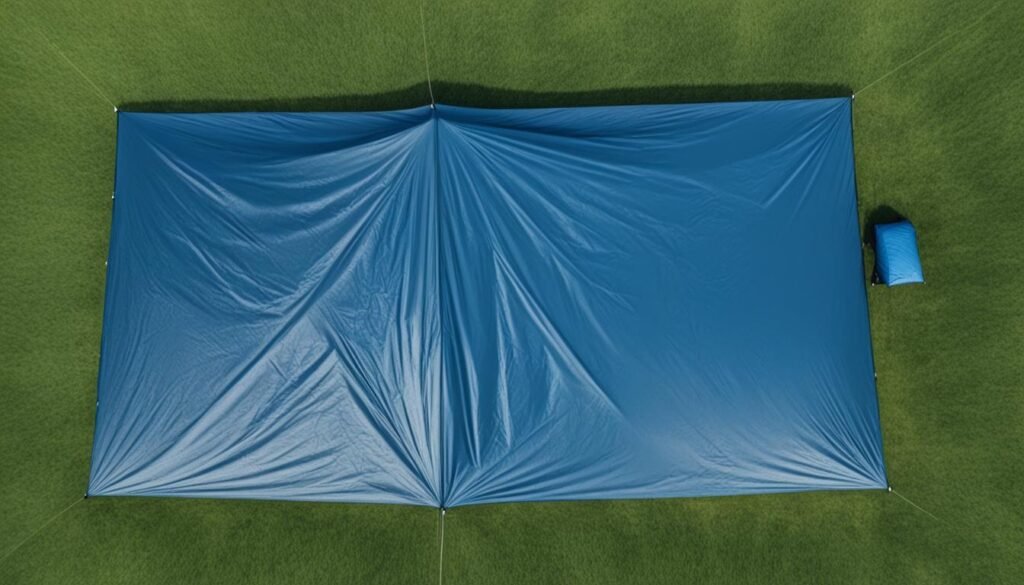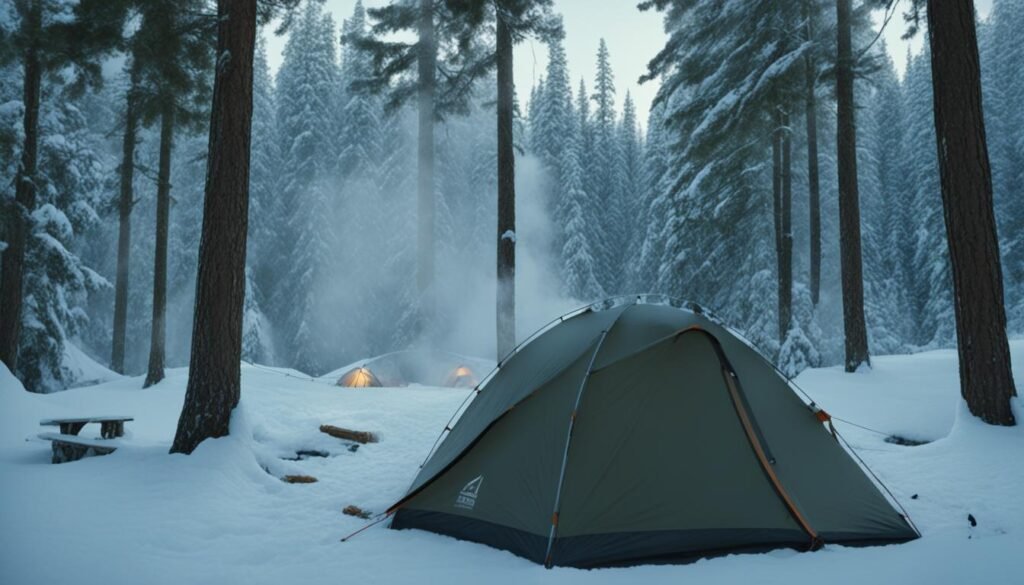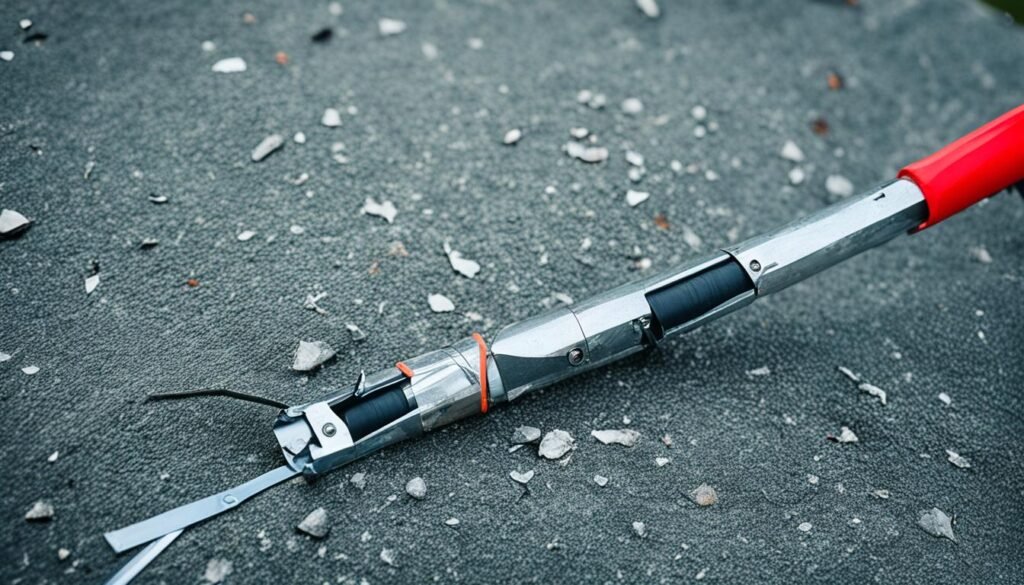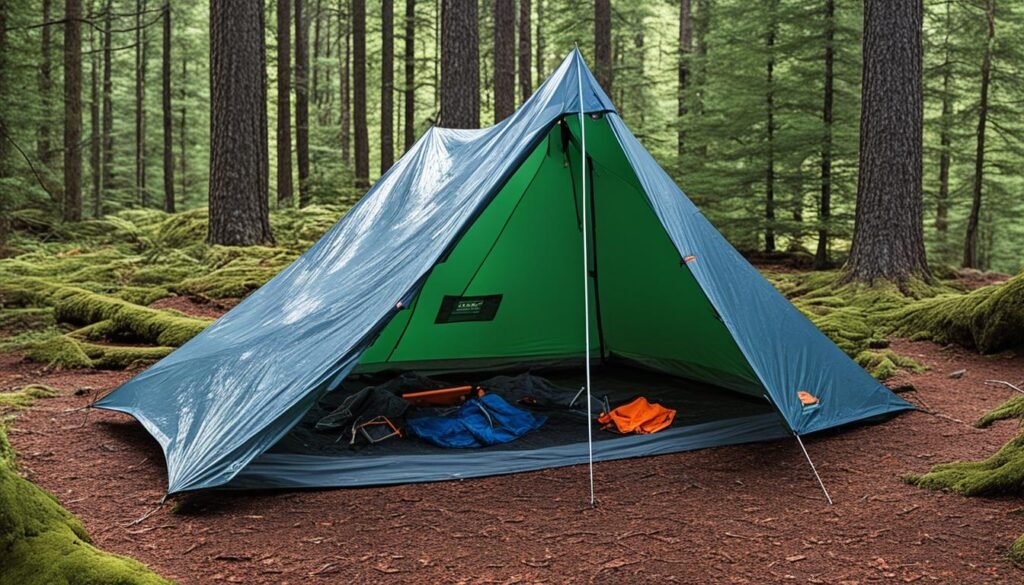Securing your tent in hard ground can be a challenging task, but with the right techniques and tools, it is possible to anchor your tent securely. When camping in areas with compacted soil or tough terrain, driving tent pegs effectively becomes essential for a stable and secure tent setup. In this article, I will share some tips and tricks for driving tent pegs into hard ground, ensuring that your camping equipment remains sturdy and safe.
Key Takeaways
- Driving tent pegs into hard ground can be challenging, but with the right techniques, it can be achieved.
- Investing in durable tent stakes and using proper tools is crucial for anchoring your tent securely.
- Listening to the sound while driving pegs can help identify rocks and adjust the position accordingly.
- Consider alternative methods such as tying your tent off to trees or rocks if driving pegs is not possible.
- Choosing the right spot with softer ground can facilitate easier peg insertion.
Why Driving Tent Pegs into Hard Ground is Challenging
The ground at established campsites and backcountry sites can present a significant challenge when it comes to driving tent pegs. The soil is often hard and compacted, making it difficult to penetrate with standard tent stakes. This can lead to bent stakes, unstable tent setups, and frustration for campers.
Camping on established campsites or backcountry sites has its benefits, such as established fire pits and proximity to amenities. However, these areas tend to have hard and compacted soil due to heavy foot traffic and usage over time. The soil becomes dense, making it challenging to drive tent pegs deep enough for secure anchoring.
“Driving tent pegs into hard ground requires alternative methods and tools to ensure a successful setup.”
In addition to established campsites, backcountry sites also pose a similar challenge. These remote locations often have rough terrain and compacted soil. Driving tent pegs into the ground can feel like a battle against unyielding resistance.
It’s crucial for campers to overcome these challenges to secure their tents properly and enjoy a comfortable camping experience. By finding alternative methods and using the right tools, campers can overcome the difficulties of driving tent pegs into hard ground.
Different Types of Tent Pegs for Hard Ground
When it comes to tent pegs, not all are created equal. Different types of terrain require different pegs to ensure a secure and stable tent setup. Here are some of the best tent pegs for hard ground:
Skewer or Wire Pegs
Skewer or wire pegs are commonly used tent pegs due to their lightweight and affordable nature. However, they may not work well on hard ground as their thin design lacks the necessary strength for stability.
Meta or V Pegs
Meta or V pegs are designed to provide more surface area for better stability. These pegs offer increased resistance against strong winds and are suitable for hard ground conditions.
Pile Driver or Screw Pegs
If you’re camping on hard and rocky terrain, pile driver or screw pegs are heavy-duty stakes that can stand up to the challenge. These pegs are designed to drive into the ground with minimal effort and provide exceptional grip and stability.
Rock Pegs
Rock pegs are strong and thin, making them ideal for hard ground. These pegs can penetrate tough soil and provide a secure anchor point for your tent.
Plastic Pegs
For sandy or soft earth, plastic pegs are a lightweight and reliable option. These pegs offer good grip in loose soil and are resistant to breaking or bending.
Choosing the right type of peg for the ground you’ll be camping on is crucial to ensure a secure and stable tent setup. Consider the terrain and your specific needs when selecting the best tent pegs for hard ground.
| Peg Type | Suitable Terrain | Key Features |
|---|---|---|
| Skewer or Wire Pegs | Not recommended for hard ground | Lightweight, affordable |
| Meta or V Pegs | Hard ground | Increased surface area for stability |
| Pile Driver or Screw Pegs | Hard and rocky terrain | Heavy-duty, exceptional grip |
| Rock Pegs | Hard ground | Strong and thin, secure anchor |
| Plastic Pegs | Sand or soft earth | Lightweight, good grip, durable |
Tips for Driving Tent Pegs into Hard Ground
Driving tent pegs into hard ground can be challenging, but with the right techniques and tools, it can be made easier. Here are some tips to help you secure your tent in tough soil:
- Using Water to Soften the Ground: Before driving the tent pegs, try pouring some water on the ground to soften it. This will make it easier for the pegs to penetrate the hard surface.
- Investing in High-Quality Pegs: High-quality tent pegs are essential for driving into hard ground. Cheap or flimsy pegs may bend or break, compromising the stability of your tent. Invest in durable, heavy-duty pegs that can withstand tough conditions.
- Listening to the Sound: When driving the pegs, pay attention to the sound. If you hear a solid, thud-like sound, it means the peg is hitting a rock or hard surface. Adjust the position and try again to find a softer spot.
- Using a Stronger Tool: If you’re struggling to drive the pegs with a mallet or hammer, consider using a stronger tool, such as a drill or a stake hammer. These tools provide more force, making it easier to insert the pegs into hard ground.
- Tying the Tent Off in Another Way: If driving the tent pegs is not possible due to extremely hard ground, you can use alternative methods to secure your tent. Consider tying ropes to nearby trees or rocks to anchor your tent securely.
- Choosing the Right Spot: When selecting a spot for your tent, look for areas with softer ground. Under trees or areas with vegetation can provide more forgiving ground for peg insertion.
By following these tips, you can overcome the challenges of driving tent pegs into hard ground and ensure a secure and stable tent setup.
| Tips for Driving Tent Pegs into Hard Ground |
|---|
| Using Water to Soften the Ground |
| Investing in High-Quality Pegs |
| Listening to the Sound |
| Using a Stronger Tool |
| Tying the Tent Off in Another Way |
| Choosing the Right Spot |
Tools to Aid in Driving Tent Pegs
When it comes to driving tent pegs into hard ground, having the right tools can make all the difference. Two tools that can significantly ease the process are tent stake drivers and tent stake extractors.
Tent stake drivers are powerful machines that are designed to automate and streamline the task of driving tent pegs. These drivers are typically powered by gasoline and utilize a jackhammer-like motion to quickly and efficiently penetrate even the most stubborn ground. With a tent stake driver, you can say goodbye to the back-breaking task of manually driving pegs into frozen or compacted ground, and instead, rely on machinery to get the job done in a fraction of the time.
On the other hand, tent stake extractors are invaluable for removing tent stakes from the ground without the need for manual labor. These extractors employ the leverage principle, allowing you to effortlessly lift and remove stakes, even if they are deeply embedded. With a tent stake extractor in your arsenal, you can bid farewell to the frustration and effort of struggling to free your tent pegs from the frozen or hard ground.
Both tent stake drivers and tent stake extractors are particularly useful for professionals or camping enthusiasts who frequently find themselves setting up tents in challenging conditions, such as frozen or compacted ground. These tools not only save you time and effort but also ensure that your tent is securely anchored, providing you with peace of mind during your outdoor adventures.
To give you a better picture of these tools, here is a table comparing their features:
| Tent Stake Drivers | Tent Stake Extractors |
|---|---|
| Powered by gasoline | Effortlessly remove stakes |
| Utilize a jackhammer-like motion | Work based on the leverage principle |
| Speed up the peg-driving process | Save time and effort when removing stakes |
| Ideal for driving pegs into frozen ground | Effective in extracting pegs from hard or compacted ground |
| Automates the driving process | Simplifies stake removal without manual labor |
As you can see, both tools offer unique benefits and can drastically improve your tent setup experience. Whether you’re a professional or a passionate camper, investing in tent stake drivers and extractors can save you time, effort, and frustration when working with difficult ground conditions.
Do You Really Need these Tools?
When it comes to camping in challenging conditions, the necessity of tent stake tools can vary depending on individual needs and circumstances. While some campers may find these tools essential for their outdoor adventures, others may find manual tent peg installation sufficient for occasional camping in cold weather.
If you frequently camp in cold weather and struggle with driving tent pegs into the frozen ground, investing in a tent stake driver and extractor can be a game-changer. The tent stake driver offers the convenience of automated peg installation, saving you time and effort. Meanwhile, the tent stake extractor allows for easy removal of stakes without manual labor, preventing frustration in frozen or hard ground conditions.
On the other hand, if you only occasionally camp in cold weather and the manual installation of tent pegs has proven successful, then these tools may not be a necessary investment for you. Manual peg installation can still be effective, especially if you have the strength and patience to overcome the challenges posed by hard ground or frozen conditions.
Ultimately, the decision to purchase a tent stake driver and extractor depends on the specific needs and preferences of each camper. If you frequently encounter cold weather camping conditions or require efficient and effortless peg installation, these tools can greatly enhance your outdoor experience. However, if you only camp occasionally in cold weather and find manual installation manageable, it may be worth exploring alternative techniques before considering these specialized tools.
A Comparison of Tent Stake Tools
| Tent Stake Tool | Pros | Cons |
|---|---|---|
| Tent Stake Driver |
|
|
| Tent Stake Extractor |
|
|
Please note that the table above provides a general comparison of tent stake tools. Individual preferences and camping conditions may vary, and it is essential to consider personal requirements when deciding whether these tools are necessary for your camping adventures.
Tips for Driving Tent Pegs in Cold Weather
Driving tent pegs in cold weather can be a challenging task due to the hard and frozen ground. However, there are a few tips that can help make the process easier and more efficient.
Using Water to Soften the Ground
One effective approach is to use water to soften the ground before driving the tent pegs. Pouring water around the area where the pegs will be inserted can help break up the frozen soil, making it more pliable. This will allow the stakes to penetrate the ground more easily and securely.
Utilizing Tent Stake Drivers
Another helpful tool for driving tent pegs in cold weather is a tent stake driver. These specialized tools are designed to automate the peg installation process, making it faster and less labor-intensive. Tent stake drivers use powerful mechanisms, such as jackhammer-like motions, to drive the stakes into the frozen ground with minimal effort.

Using Tent Stake Extractors for Removal
When it’s time to pack up and leave, removing the tent stakes from frozen ground can be a challenging task. In such situations, tent stake extractors can come in handy. These tools utilize lever physics to make the stake removal process easier and less physically demanding. Tent stake extractors provide the necessary leverage to lift and remove the stakes from the frozen ground without causing strain or damage.
By following these tips, you can overcome the challenges of driving tent pegs in cold weather and ensure a secure and stable tent setup. Water can soften the frozen ground, tent stake drivers automate the installation process, and tent stake extractors ease the removal of the stakes. With these techniques and tools, you can enjoy a comfortable camping experience even in harsh, wintry conditions.
Alternative Methods for Securing Tents in Hard Ground
If driving tent pegs into hard ground is not feasible, there are alternative methods you can use to secure your tent. These techniques provide stability and prevent the tent from moving or collapsing, ensuring a safe and comfortable camping experience.
Tying Ropes to Trees or Rocks
One alternative method is to tie ropes to nearby trees or rocks. Find sturdy and secure anchor points, such as thick tree trunks or large rocks, and attach your tent ropes to them. This technique distributes the tension and helps keep the tent in place even on hard ground. Ensure that the knots are tight and secure to prevent any slippage during windy conditions.
Innovative Anchoring Techniques
Another innovative way to secure your tent is by exploring alternative anchoring techniques. One method is to use sandbags or heavy objects to anchor the corners of your tent. Fill sturdy bags with sand or rocks and attach them to the guylines or tent corners. This method provides additional stability and prevents the tent from shifting or collapsing.
Additionally, you can consider using specialized tent anchors or stakes designed for hard ground. These innovative stakes often feature unique shapes or designs that provide better grip and penetration on compacted or rocky terrain. They can be a valuable investment for frequent campers who frequently encounter challenging ground conditions.
By using alternative methods such as tying ropes to trees or rocks and exploring innovative anchoring techniques, you can securely set up your tent even in hard ground conditions. These alternative methods provide stability and ensure your camping experience is safe and enjoyable.
Importance of High-Quality Tent Pegs
When it comes to securing your tent and ensuring a stable setup, investing in high-quality tent pegs is of utmost importance. These durable stakes provide the stability needed to prevent tent collapse and withstand tough outdoor conditions, keeping you safe and comfortable during your camping adventures.
High-quality tent pegs offer several key benefits that contribute to the overall stability of your tent setup:
- Superior Stability: With their strong construction and reliable design, high-quality tent pegs provide better stability, keeping your tent securely anchored to the ground even in windy conditions.
- Prevent Tent Collapse: The durability of these stakes ensures that they won’t bend or break, reducing the risk of tent collapse and damage to your camping equipment.
- Longevity: High-quality tent pegs are built to last. Their robust materials and construction make them more resistant to wear and tear, allowing for repeated use without compromising their functionality.
By investing in high-quality tent pegs, you can have peace of mind knowing that your tent will remain stable and secure throughout your camping trip, regardless of the terrain or weather conditions you encounter.
| Type of Tent Peg | Suitable Terrain |
|---|---|
| Skewer or Wire Peg | Soft soil, grassy areas |
| Meta or V Peg | Various terrains, provides stability |
| Pile Driver or Screw Peg | Hard or rocky ground |
| Rock Peg | Hard and compacted soil |
| Plastic Peg | Sand or soft earth |
Choosing the right type of tent peg for your specific camping needs is crucial for achieving optimal stability. The table above showcases various tent peg options suitable for hard ground, offering alternatives that cater to different types of terrain.
Best Practices for Driving Tent Pegs
When it comes to securing your tent in challenging terrain, following best practices for driving tent pegs is crucial. By using the proper technique and tools, you can avoid bent stakes and ensure a secure and stable tent setup.
One of the most important aspects of driving tent pegs is using the right tools. A sturdy mallet or hammer is essential for effectively driving the stakes into the ground. Additionally, having a stake extractor on hand can make the removal process easier and prevent any damage to the pegs.
“Using the proper technique and tools is key to achieving a secure and stable tent setup in challenging terrain.”
To drive tent pegs without bending them, it’s important to choose the right spot for your tent. Look for areas with softer ground, such as grassy areas or underneath trees, as these spots will allow for easier peg insertion. Avoid rocky areas that may damage the stakes or make driving them more difficult.
Properly securing the tent is also crucial for stability. Follow these steps:
- Start by driving the corner pegs of the tent.
- Ensure the pegs are inserted at a 45-degree angle for maximum stability.
- Attach the guy lines to the tent and pull them tight to create tension.
- If necessary, use additional pegs or rocks to anchor the guy lines for extra stability.
By following these best practices, you can ensure that your tent is securely anchored, even in challenging terrain.
Key Takeaways:
- Choose the right tools, such as a mallet or hammer, and consider using a stake extractor.
- Drive the pegs into softer ground and avoid rocky areas.
- Properly secure the tent with guy lines and additional anchors if needed.
Choosing the Right Spot for Tent Setup
When it comes to setting up your tent, selecting the right spot can make a significant difference in the ease of peg installation and the stability of your setup. To ensure a smooth process and a secure tent, consider these key factors:
- Softer Ground Options: Look for areas with softer ground, as it will be easier to drive the tent stakes into the soil. Soft ground provides better traction and allows for more effective peg insertion.
- Under Trees: Setting up your tent under trees not only offers shade but also increases the chances of finding softer ground. The forest floor tends to have a layer of decomposing leaves and organic matter, creating a softer surface for easier peg installation.
- Avoiding Rocky Areas: When scouting for a tent spot, steer clear of rocky areas. Rocks can obstruct proper peg penetration and may damage your stakes. Opt for a location free of rocks and large stones to ensure a stable and secure tent setup.
By taking these factors into account, you can significantly simplify the tent setup process and maximize the stability of your camping experience.
For a visual representation of the importance of choosing the right spot for tent setup, refer to the table below:
| Spot Type | Suitability for Tent Setup |
|---|---|
| Soft ground under trees | Highly suitable |
| Grassy areas | Moderately suitable |
| Rocky areas | Not suitable |
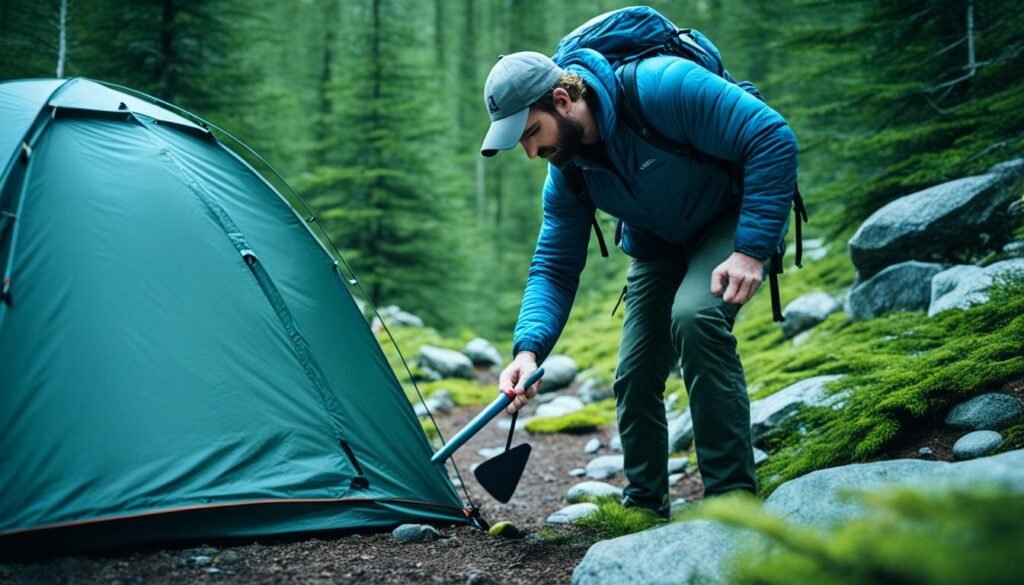
Considerations for Different Types of Terrain
When it comes to tent camping, adapting to different types of terrain is crucial for a secure and stable setup. Peg installation techniques vary depending on the ground conditions. Whether you’re camping on rocky terrain, sandy soil, or grassy areas, here are some considerations to keep in mind:
Rocky Terrain
In rocky terrain, it’s important to use pegs that can handle the tough conditions. Consider using rock pegs or pile driver/screw pegs, as they provide better anchorage in rocky surfaces. These sturdy pegs are designed to penetrate the hard ground and offer stability even in challenging environments.
Sandy Soil
When setting up a tent on sandy soil, traditional metal pegs may not provide sufficient grip. It’s recommended to use plastic pegs, which are designed to dig deep into the soft sand and prevent the tent from shifting or collapsing. These pegs offer better resistance against the loose texture of sandy soil.
Grassy Areas
Grassy areas typically offer a more forgiving terrain for tent camping. The soil is softer and easier to penetrate with regular tent pegs. However, it’s still essential to ensure proper peg insertion to maintain stability. In grassy areas, you may face minimal resistance when driving the pegs into the ground.
By adapting your peg installation techniques to the specific terrain you encounter, you can ensure a secure and stable tent setup. Whether you’re camping on rocky terrain, sandy soil, or grassy areas, choosing the right pegs will help anchor your tent effectively and provide a comfortable camping experience.
Conclusion
Securing tents in hard ground can be a challenging task for campers. However, by following the right tips and techniques, it is possible to make this process easier and ensure a stable tent setup. One crucial aspect is investing in high-quality tent stakes that can withstand the tough conditions of hard ground. These durable stakes provide better stability and prevent the risk of tent collapse.
Using proper tools and methods is also essential. Techniques such as using water to soften the ground before driving the pegs, listening to the sound to identify potential obstacles, and choosing the right spot with softer ground can greatly assist in driving tent pegs effectively. Additionally, utilizing stronger tools like hammers or drills can create pilot holes for easier insertion.
Adapting to the specific terrain is equally important. Different types of terrain require different peg installation techniques. For rocky ground, rock pegs or heavy-duty stakes like pile driver/screw pegs are recommended. Sandy soil may require plastic pegs for better grip, while grassy areas may allow for easier insertion. Considering the terrain conditions and adapting accordingly ensures a secure and stable tent setup.
By implementing these tips and techniques, campers can enjoy a safe and comfortable camping experience, even in hard ground. Securing tents properly not only provides peace of mind but also protects against potential damage or collapse. So remember, invest in high-quality tent stakes, use the right tools and methods, and adapt to the specific terrain. With these guidelines, you can confidently secure your tent in even the toughest ground conditions.
FAQ
How can I drive tent pegs into hard ground effectively?
There are several tips and techniques you can use to drive tent pegs into hard ground effectively. Some of these include using water to soften the ground, investing in high-quality pegs, listening to the sound to identify rocks, using a stronger tool, tying the tent off in another way, and choosing the right spot for peg insertion.
What types of tent pegs are best suited for hard ground?
Different types of tent pegs are designed for different types of terrain. For hard ground, meta or V pegs, pile driver or screw pegs, rock pegs, and plastic pegs are all good options depending on the specific conditions.
Are there any tools that can aid in driving tent pegs into hard ground?
Yes, there are tools available that can help with driving tent pegs into hard ground. Tent stake drivers, powered by gasoline, use a jackhammer-like motion to drive stakes into the ground easily and quickly. Tent stake extractors use lever physics to remove stakes from the ground without manual labor.
Do I really need tent stake tools for driving tent pegs into hard ground?
The necessity of tent stake tools depends on your individual needs and the frequency of camping in challenging conditions. If you frequently camp in cold weather or struggle with manual tent peg installation, investing in a tent stake driver and extractor may be beneficial. However, if you only occasionally camp in these conditions, it may be worth trying manual installation first before considering the tools.
How can I effectively drive tent pegs in cold weather?
Driving tent pegs in cold weather can be challenging due to the harder and firmer ground. Some tips for effective peg installation in cold weather include using water to soften the ground before driving the pegs and considering using tent stake drivers, especially designed for frozen ground conditions.
What are some alternative methods for securing tents in hard ground?
If driving tent pegs into hard ground is not feasible, there are alternative methods for securing tents. Tying ropes to trees or rocks can provide stability and prevent the tent from moving or collapsing. Innovative anchoring techniques can also be explored to ensure a secure and stable tent setup.
How important is it to invest in high-quality tent pegs?
Investing in high-quality tent pegs is essential for a stable and secure tent setup. High-quality stakes provide better stability and can withstand tough conditions without bending or breaking. They are more durable and ensure the longevity of the tent stake.
What are some best practices for driving tent pegs?
Some best practices for driving tent pegs include using the proper technique and tools, such as mallets or hammers and stake extractors. Avoiding bent stakes is crucial for a secure tent setup, especially in challenging terrain. Properly securing the tent ensures stability and prevents damage or collapse.
How can I choose the right spot for tent setup?
Choosing the right spot is important for easier peg installation. Areas with softer ground, such as under trees, can make it easier to drive the tent stakes. Avoiding rocky areas is essential to prevent damage to the stakes and ensure a stable tent setup.
What should I consider when camping in different types of terrain?
Different types of terrain require different techniques for peg installation. In rocky terrain, using rock pegs or pile driver/screw pegs may be more effective. Sandy soil requires plastic pegs for better grip, while grassy areas may allow for easier peg insertion. Adapting to the specific terrain conditions ensures a secure and stable tent setup.


